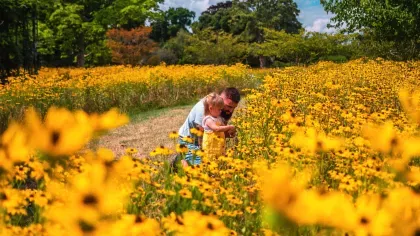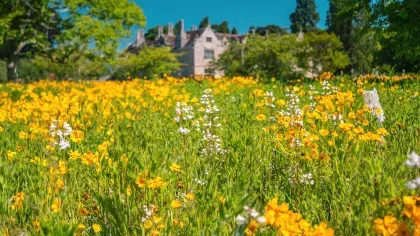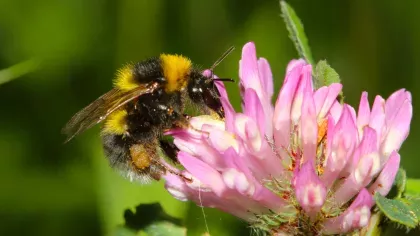6 September 2023
Wakehurst’s American Prairie: The next chapter
For visitors to Wakehurst last year, the American Prairie’s sea of yellow was hard to miss and hard to forget. But it’s been looking slightly different this year, and there are plenty of reasons why.

Through a careful process of habitat management techniques, cultivation and planting, we’re helping our six-acre prairie to develop, evolving into a new spectacle every year.
Let’s catch up
Beginning with a North American seed-collecting trip in 2019, the American Prairie started life at the Millennium Seed Bank, where the perfect seed blend was created, to be hand-sown across the landscape in 2020.
A selection of seeds were held back, nurtured by experts in the nursery, and grown into 50,000 plug plants, each hand-planted a year later. In preparation for the plug plants, we had to wave goodbye to the prairie’s first summer in flower, as the six acres were mown.
A year on, we celebrated the summer spectacle anew, with a dazzling carpet of tickseed (Coreopsis) and black-eyed Susan (Rudbeckia) supplying an unmissable sight.
Not only a sight of botanical wonder, our American Prairie is a beautiful blend of horticulture and science, epitomising our role as a ‘living laboratory’, where ground-breaking science takes place right on site.

Getting the lay of the land
Now, it’s all about experimentation. With over 50 species establishing their place on the prairie, we want to ensure that each one has a chance to shine. Certain species will fare better in our changing climate, whilst others will require more handholding.
This summer, our Prairie Gardener, Jack, has been cutting down native weeds to prevent them from seeding, whilst allowing more sunlight to reach the prairie plants below, with minimal disturbance to the soil.
Although time-consuming, this gives our prairie plants a chance to seed and flourish.
New introductions with old friends
In other areas across the landscape, we’ve given our native plants an even shorter haircut, opening up space to introduce new plug plants, and tipping the balance in favour of the new non-native species.
Eleven species, grown in the nursery, have been introduced to the prairie this summer, including white wild indigo (Baptisia alba), wild bergamot (Monarda fistulosa) and wild lupine (Lupinis perennis), an old favourite from the prairie’s first few years.


What to spot where
Nearest the Mansion, the Atlantic Coastal Plain zone, evoking east coast prairie habitats, is lining up for a September showcase. Don't miss a beautiful swathe of delicate sky-blue smooth aster (Symphyotrichum laeve) and showy aster (Eurybia spectabillis).
Other notable species include:
- Flowering spurge (Euphorbia corollata)
- Gray goldenrod (Solidago nemoralis)
- Western sunflower (Helianthus occidentalis)
- Hyssopleaf thoroughwort (Eupatorium hyssopfolium)
Across the paths, in the South-Central Prairie, keep an eye out for first-time flowering big blue stem (Andropogon gerardii), nodding onion (Allium cenuum), wild quinine (parthenium integrifolium) and prairie dropseed (Sporobolus heterolepis). The latter has been said to smell like hot popcorn for some people, and coriander to others!
Venturing towards the Pinetum, one area of the prairie looks slightly different from the rest. Having had a head start in the nursery, these prairie species have an advantage in the battle against native weeds. Bright yellow Rudbeckia and the recognisable spiked heads of rattlesnake master (Eryngium yuccifolium) stand tall, giving a taste of the scale and colour we’re expecting across all three prairie zones.

Looking ahead
For the seasons ahead, we’ll continue to monitor the prairie, as each plant takes its place in this diverse ecosystem. Each year will be different, as the layers of plants evolve amongst the dynamic mix of native and non-native species.
For those areas that are struggling, we’ll create new seed mixes to sow, and will trial different cutdown methods, such as burning, mowing and raking.
Next year, we’ll be focusing our efforts on creating two new beds from scratch in the South-Central zone. These beds will then retell the story of our American Prairie from the start, transforming into a bright sea of yellow once again.


